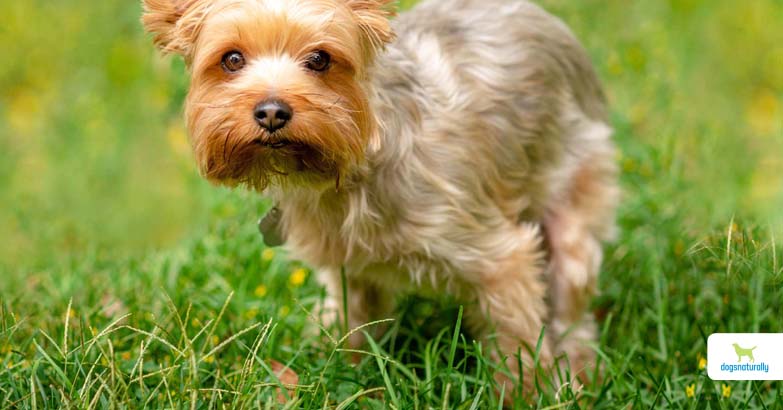Being aware of your dog’s bowel movements is a big part of dog ownership. After all, you can’t help but notice when something’s a little off during the stoop and scoop. Even if you’re not monitoring your dog out in the yard, it’s a good idea to pay attention to what’s coming out.
Maybe you’ve noticed that your dog’s stools are harder and lumpier than usual. Or maybe it’s been a day or two since you had to clean up after him. Whatever the reason, you’re pretty sure your dog has constipation. And you know you have to do something about it before it makes him sicker.
Most conventional vets will prescribe pharmaceutical laxatives. But prescription laxatives aren’t the best options. Natural laxatives are much safer and just as effective.
But before we talk about natural laxatives for dogs and other ways to relieve constipation naturally, let’s make sure you know why it’s happening.
What Causes Constipation In Dogs?
The most common reasons dogs get constipated is that they ate something they shouldn’t have. This can include stones, pieces of toys, or something they found in a bush during their walk. If big enough, these items can cause bowel obstructions, which can be life threatening if they aren’t dealt with.
But there are lots of other reasons for constipation in dogs …
Diet
Too much or too little fiber in your dog’s diet may cause constipation. Your dog may also find it difficult to pass stools if he has too much calcium (usually from bones) or fat in his diet.
If the constipation is due to too much bone in your dog’s diet, your dog’s stool will look dry, chalky and crumbly. Constipation from bone is also common in dogs who are switching to raw.
Exercise
If your dog doesn’t get enough exercise it may slow the movement of stools through his colon. This can cause the colon to absorb too much water from the stool, causing constipation.
Hair
Matted hair around the anus can stop your dog from being able to pass stools properly, which can lead to constipation. Your dog can also get constipated from over-grooming, which may lead to too much hair in his stool.
Dehydration
If your dog doesn’t drink enough water, his intestines can’t add enough water to his stool before it enters the colon. This can lead to hard, dry stools and constipation. To check for dehydration do a pinch test.
Pinch a fold of skin on your dog’s neck. It should bounce back into place in a second. If it takes longer, your dog is most likely dehydrated. Always provide fresh filtered water for your dog. Adding a little bone broth may encourage him to drink more.
Age
As dogs age, their systems start to slow down. It’s common for older dogs to have problems with constipation.
Stress
Your dog’s brain and digestive tract are constantly communicating with each other. This helps regulate bodily functions. But that also means stress and anxiety can affect your dog’s digestive tract. The most common digestive issues related to stress are diarrhea, stomach pain and constipation.
Inflammation
If there’s inflammation in your dog’s intestines or rectum, it can cause constipation and many other digestive issues. It can also lead to inflammatory bowel disease.
Medication
If your dog’s constipation started around the same time he started a new medication, that could be the cause. Diuretic, antihistamine and cancer drugs are common culprits of this side effect.
Disease
Certain diseases can cause constipation. Dogs with hypothyroidism, an enlarged prostate gland or organ problems can experience constipation. Tumors in the digestive and eliminatory organs can also cause obstructions and constipation.
Injury
If your dog has a spinal, hip or pelvic injury, it can make defecating more painful. This can eventually lead to constipation if your dog isn’t pooping often enough.
Blocked Anal Sacs
Your dog has a small sac on each side of his anus, commonly called anal glands. These sacs release a small amount of fluid when your dog poops. The scent of this fluid helps dogs mark their territory and identify each other. But sometimes these anal sacs get blocked and can make it hard for your dog to poop, leading to constipation.
RELATED: DIY solutions for dog anal gland problems …
Symptoms Of Constipation In Dogs
Normally, dogs poop once or twice a day. But when your dog gets constipated, his bowel movements will be much less frequent. If your dog hasn’t pooped in more than 24 hours, he’s most likely constipated.
Other signs of constipation include …
- Straining to poop (with or without producing any stool)
- Crying out while pooping
- Bowel movements that take longer to pass
- Rock hard stools that don’t leave residue when picked up
If your dog is showing any of these, then there are lots of natural treatments you can try to get things moving. We’ll share some of these in a bit.
When To Call Your Holistic Vet
When dealt with early on, you can manage your dog’s constipation from home with natural remedies. But if it’s untreated you may need help from a professional. If more than 3 days have passed since your dog’s last bowel movement or you see any of these more severe symptoms, call your holistic vet.
- Vomiting
- Loss of appetite
- Lethargy
- Distended abdomen
- Abdominal pain
The Truth About Prescription Laxatives For Dogs
When dogs get constipated, conventional vets often use prescription laxatives. But these can be harmful to your dog. To understand why, let’s look at what laxatives are and how they work.
What Are Laxatives?
Laxatives are substances or medications that help promote bowel movements and relieve constipation by increasing the frequency or ease of passing stools. When most people think of laxatives, prescription laxatives immediately come to mind. And these are often what vets will prescribe constipated dogs.
Types Of Laxatives | How Do Laxatives Work?
These are the three most popular types of prescription laxatives and their actions:
- Bulk-Forming Laxatives: These help make stool bigger and softer by retaining water in the stool. But your dog needs to drink lots of water if he takes them, or else there is risk of getting bloated or blocked up. Examples of bulk-forming laxatives are psyllium, dietary fiber, and methylcellulose.
- Osmotic Laxatives: These don’t get absorbed well by the body, so they pull water into the intestines. This helps make stool easier to pass. Some common osmotic laxatives include milk of magnesia, lactulose, sorbitol, and polyethylene glycol (PEG).
- Stimulant Laxatives: These work by stimulating the muscles in the intestines. They also make the intestines produce more fluid. Some examples of stimulant laxatives are bisacodyl, senna, cascara, and sodium picosulfate (SPS). Sometimes, you can even find senna and cascara in herbal teas or natural remedies.
The most common prescription laxative for dog constipation is lactulose. This is a synthetic sugar that works by drawing water into your dog’s colon and stools.
The Problem With Prescription Laxatives For Dogs
The problem is that prescription laxatives don’t solve the underlying issue … they just relieve the symptoms. And the body can also become dependent on these laxatives if you use them too often. The muscles of the intestine lose tone and nerve response and become unable to push out stool on their own.
There are also many well known adverse side effects of laxatives, including abdominal pain, diarrhea and dehydration.
With so many natural laxatives and other ways to get things moving, there’s no need to use prescription laxatives for dogs. If you do decide to use them, always do so with the guidance of a professional. And never give your dog human laxatives as they can be even more dangerous for dogs.
The Best Natural Laxatives for Dogs
Since prescription laxatives have so many side effects and other risks, it’s best to use natural laxatives. There are lots of mild natural laxatives that can stimulate the bowel.
Aloe – Aloe vera is a natural laxative that helps stimulate muscle contractions and lubricates the digestive tract. It also has a high water content, which can help add moisture to your dog’s stool.
Use food-grade gels or juices made from the inner fillet. Add up to ¼ tsp per 10 lbs of body weight to your dog’s food.
If you’re buying fresh leaves from the grocery store or using leaves grown at home, make sure to avoid the aloe latex. This is the yellow substance on the inside of the leaf. It’s commonly used for human laxatives but is very toxic to dogs. Fresh aloe leaves will keep in the fridge for 3 days.
Apple Cider Vinegar – Some believe that apple cider vinegar can increase contractions inside the colon to move waste out. This natural laxative for dogs is also prebiotic, which helps support digestive health. (We’ll talk more about prebiotics in preventing constipation.)
If you do use apple cider vinegar always mix it with your dog’s water or food. Never give it straight. Dose based on your dog’s weight.
Up to 14 lbs … 1 tsp
15 to 34 lbs … 2 tsp
35 to 84 lbs … 1 tbsp
How To Get Rid Of Your Dog’s Constipation Naturally
If the natural laxatives above aren’t working, there are other strategies to get rid of your
The first thing you should do if your dog gets constipated is consider what he’s eaten over the last few hours. Did you add something new to his diet? Did he get into something he shouldn’t have?
If nothing obvious comes to mind, the next thing you should do is check for visible problems. This may include matted hair, lumps or foreign objects at the opening of the anus. You’ll also want to check for dehydration. You can do this using the pinch test I mentioned earlier.
Finally, try taking your dog for a walk or play a game of fetch. Exercise can help get your dog’s gastrointestinal tract moving.
If none of these work, try these natural remedies. We recommend trying them in order and then waiting a few hours before you move onto the next. This will make sure you don’t strain your dog’s system than necessary.
1. Fiber-Rich Foods
There are two types of fiber: soluble and insoluble. Soluble fiber dissolves in water. When this happens, it creates a gel that can help improve digestion. It can help bulk up stool and increase nutrient absorption. It also bulks up stool to help prevent constipation and diarrhea.
But when your dog is already constipated, insoluble fiber is what he needs. Insoluble fiber draws water into your dog’s stool, which will help soften it.
Fruits and vegetables like pumpkin, green beans, zucchini and carrots are good sources of insoluble fiber. They also have high water content that can help hydrate your dog.
2. Organ Meat
If your dog gets constipated, add organ meat to his diet. This will be especially effective if he’s not used to organ meat (so don’t overdo it).
If you’re already feeding organ meat as part of your dog’s diet, add more until his constipation passes. You can also try an organ supplement if fresh organs aren’t your cup of tea.
3. Lubricating Herbs
Another way to help relieve your dog’s constipation is to feed lubricating herbs. They help increase mucus production and create a gel like substance called mucilage. Together, this helps guide the poop out of your dog’s colon.
Popular herbs include:
Marshmallow Root – Marshmallow root helps reduce inflammation, soothe the digestive tract and moisten the mucus membranes. It’s especially beneficial if there’s mucus in your dog’s stool. Canine herbalist Rita Hogan recommends using marshmallow root capsules (size 00). Give the following amount for 2 to 3 days.
Small dogs … ½ capsule (you can break it open and divide the powder)
Medium dogs … 1 capsule, twice daily
Large dogs … 2 capsule in the morning, 1 in the evening
Extra large dogs … 2 capsules, twice daily
Plantain – The seeds and husks of plantain are a good source of fiber. Plantain reduces inflammation and pain. It also helps detoxify waste. It’s best to use a tincture. Give your dog 20 drops per 15 lbs of weight 3 times daily. If your dog is sensitive to the tincture or has an autoimmune disease, dilute the tincture in an ounce of water.
Chickweed – This is a very gentle laxative that helps soothe the digestive tract. It helps lubricate the large intestine and cools the tissue to soothe it. Use chickweed in tincture form and follow the same instructions as plantain … 20 drops per 15 lbs. You can dilute it in an ounce of water if it will be easier to give to your dog this way.
Slippery Elm – Slippery elm works like marshmallow root to soothe and lubricate the digestive tract. Give your dog ¼ tsp of powder per 10 lbs of body weight.
Flax Seeds – Flax is a good source of fiber and creates mucilage to lubricate the colon. Give your dog ¼ tsp per 20 lbs of body weight.
4. Pick A Stronger Natural Laxative
If nothing else has worked, it may be time for a stronger solution. While natural, you should only use these options when absolutely necessary and with guidance from a holistic vet.
Ask your holistic vet about the correct dosage for your dog.
Senna – Senna can be very effective but improper use can lead to diarrhea. Long-term use can also lead to dependence. You shouldn’t use senna if you suspect a bowel obstruction or if your dog has symptoms of abdominal discomfort.
Cascara sagrada – You shouldn’t use this laxative for constipation in lactating dogs. Mother’s can pass it on to nursing pups through their milk. For safe options for pregnant dogs, keep reading.
Turkey Rhubarb – This herb is commonly used for digestive issues including constipation. It’s a short-term solution and can cause diarrhea and cramping.
Safe Natural Laxatives For Pregnant Dogs
If you have a pregnant dog, it’s especially important to steer clear of laxative drugs. Laxatives work by increasing movement in the digestive tract. This can stress out the fetus and reproductive organs.
If your pregnant dog gets constipated, focus solely on lubricating the digestive tract with …
- Marshmallow
- Flaxseed
- Chickweed
Why You Shouldn’t Use Milk As A Laxative
Some dog owners use milk for dog constipation. It “works” because most dogs are lactose intolerant … so it causes digestive upset and diarrhea. But it can also lead to bigger issues, so it’s best not to use milk as a remedy for your dog’s constipation.
Chronic Constipation In Dogs
Constipation is a common digestive problem in dogs but is usually acute. That means it only lasts a few days and is often caused by a change in diet or routine.
Chronic constipation is an entirely different beast. It can last for long periods of time. It may even stick around for years.
Chronic constipation is most often caused by a dysfunctional liver or liver congestion. When the liver isn’t working properly, bile production slows. Bile is an important part of the elimination system. If there isn’t enough bile or it’s too thick, fat will build up and slow down the digestive tract, which increases the chances of constipation.
For chronic constipation stemming from liver problems, your holistic vet may prescribe …
- Milk thistle
- Turmeric
- Licorice
- Omega-3 fatty acids
These will help protect and repair the liver to help keep it functioning properly.
Similar problems can occur if the gallbladder or bile ducts become blocked. The digestive tract won’t get everything it needs to properly break down food and constipation will occur. In these cases you can try dandelion root or Oregon grape. They improve bile production and transport to push stools out of the body.
Tonic For Chronic Constipation
If your dog has chronic constipation, herbalists Mary Wulff and Gregory Tilford recommend this tonic.
2 parts dandelion root
2 parts marshmallow root
1 part Oregon grape
1 part yellow dock
You can also add 1 part fennel to help with gas
You can use tinctures, teas or herbs to make this tonic. If using herbs or tea, give 1 tsp per 30 lbs of body weight 2 to 3 times daily. With tincture, you can give 1 ml per 30 lbs, 2 or 3 times a day.
How To Prevent Constipation In Dogs
Because constipation can come and go, it’s important to know how to prevent it. The most important step is making sure your dog doesn’t eat anything he shouldn’t. But I know this is easier said than done (especially with sneakier dogs). So here are some more tips.
1. Feed Raw
Raw food is easier on the digestive tract. This will help reduce inflammation and irritation. It’s also full of the whole natural vitamins and nutrients your dog needs to stay healthy. This will help make sure his systems are functioning properly.
2. Feed Fruits And Veggies
This goes hand in hand with raw but even if you’re committed to kibble, you can add fruits and veggies. Why feed them? They’re full of fiber, which helps regulate bowel movements.
3. Add Digestive Enzymes
Digestive enzymes help break down food. This is important because undigested food can cause blockages and constipation. Digestive enzymes also help your dog get more nutrients from his food.
Digestive enzymes are especially important if your dog eats processed food. That’s because the digestive enzymes get destroyed when heated. If your dog eats raw food, he will be getting his enzymes naturally. But some holistic veterinarians recommend digestive enzymes for all dogs, even if they’re raw fed.
RELATED: When to use digestive enzymes for dogs …
4. Add Prebiotics And Probiotics
Pre- and probiotics help improve your dog’s digestive health. Prebiotics are non-digestible soluble fiber that feed probiotics. Probiotics are healthy bacteria that make their way to your dog’s colon, where they ferment prebiotics and produce healthful benefits.
When choosing a probiotic look for one with a variety of strains and at least 30 billion colony forming units (CFU). If using a soil based probiotic, you only need 1 to 2 strains and less than 1 billion CFU.
If you use a probiotic supplement, you can find ones with prebiotics as well. Or you can use prebiotic foods like mushrooms, berries, dandelion greens or garlic
RELATED: Read more about prebiotics for dogs …
Digestive upset is common in dogs … whether it’s constipation, diarrhea or some other problem with his gut. The good news is there are natural ways to prevent and manage it. So before you reach for conventional drugs, try some of these safe and effective natural remedies.












